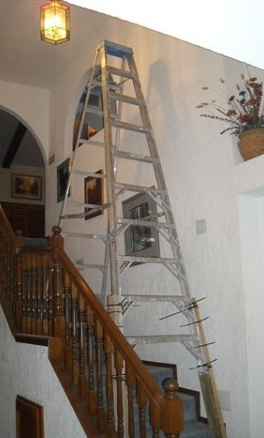No matter what the project is, there are a few basic "must" safety issues and procedures.
- Always where eye protection. It doesn’t matter whether you are painting, removing a wall or building a deck. Paint splatters, drywall and plaster create enormous amounts of highly abrasive dust, and it is impossible to know when the head of a nail will shear off when struck by a hammer.
- Gloves
- Safety shoes or boots
- Read "all" the safety instructions provided bythe manufacturer of power tools and materials that you are using,especially chemical products.
- Dust mask
When working on projects there are a few other safety items that should be considered.
While doing any electrical work, all jewellery including rings and bracelets should be removed. Most jewellery and especially gold jewellery are excellent electrical conductors. Should a piece of jewellery accidentally touch a live circuit it can arc weld itself to the circuit and hence the individual cannot free themselves and are electrocuted.
Loose fitting clothes and long sleeves should be avoided. If the climate requires long sleeves then the sleeves should fit tight to the arm and not dangle. Loose fitting clothing has a tendency to get caught on protruding objects such as nails and screws.

Figure 1 - Enroute to a broken leg - at best!
When using power tools, ensure that the electrical extension cord is rated for the power tool that you are using and the distance from the outlet. Using extension cords that do not meet the electrical specifications of the power tool will reduce the current flow to the motor and reduce its life dramatically. As well, the smaller the gauge of the extension cord the higher the heat dissipation from the cord itself, with the potential of causing a fire.
Using the "right" ladder is a critical part of safety, as shown in Figure 1. In the majority of cases, step ladders are not designed to have weight on the top rung. Extension ladders have a minimum overlap between sections. Again, it is crucial to read the safety labels and instructions on all ladders to ensure proper utilization.
CPSC warns that consumers can be electrocuted when they use metal ladders near overhead wires. Consumers often use metal ladders near overhead wires to clean gutters, paint structures, trim trees, and repair roofs and chimneys.
Based on the latest statistics available, CPSC estimates that 65 people died each year between 1985 and 1989 from electrocution when someone was using a metal ladder which contacted an electrical wire in or around the home.
Electrocutions often occur when:
Homeowners move metal ladders accidentally touching an overhead electrical wire near the house or street. Metal ladders conduct electricity, which can kill anyone touching the ladder.
- Metal ladders shift position. Wind, uneven ground or reaching to the side while on the ladder can cause the ladder or person to contact an overhead wire.
- Homeowners use metal ladders while handling an improperly grounded power tool or contacting an electrical source, such as a light socket.
- Metal stepladders and extension ladders meeting Underwriters Laboratories and American National Standards Institute voluntary standards have labels warning about this hazard. The labels typically state with words and graphic:
Danger!
Metal conducts electricity!
Keep ladder away from power lines and live electrical wires.
Despite these and other warnings, electrocutions still occur each year. To avoid this hazard, CPSC advises you to use a ladder, that does not conduct electricity, such as fiberglass or wood, when working near overhead wires.
If you must use a metal ladder, follow these precautions:
- Carefully check the location of all overhead wires before using a ladder, especially where the lines connect to the house. Any power line (including the line running from the street to your house) can permit electricity to flow into a piece of metal or 3 other object, such as a wet tree branch, that touches it.
- Lower the ladder when carrying or moving it, to avoid touching an overhead wire. Since long ladders can be unwieldy, have someone help carry and set up the ladder.
- Never work on a windy day a gust of wind can cause the ladder to shift and touch an overhead wire.
- Never place a ladder where it could slide into an overhead line. Make sure the distance to the nearest overhead line is at least twice the length of the ladder.
- Place the ladder's feet on solid, level ground before climbing it. When the ground is not level or is soft, put a flat piece of wood under one or both feet of the ladder to provide a solid, level base. If possible, tie off the ladder to prevent it from moving.
- If the ladder should start to fall into an overhead line, let it go. Never try to move it. Do not leave the ladder unattended Have someone call the power company and ask them to cut off electricity to the line, before you move the ladder. If someone is holding the ladder when it contacts the overhead line, never try to pull them away with your hands. Use something that does not conduct electricity, such as a long piece of dry wood or rope, to push or pull them loose.
Power lines and phone lines often appear similar. Assume all overhead wires carry electricity. Some overhead lines are coated to extend the life of the line. The coating is not intended to protect against electrocution.
